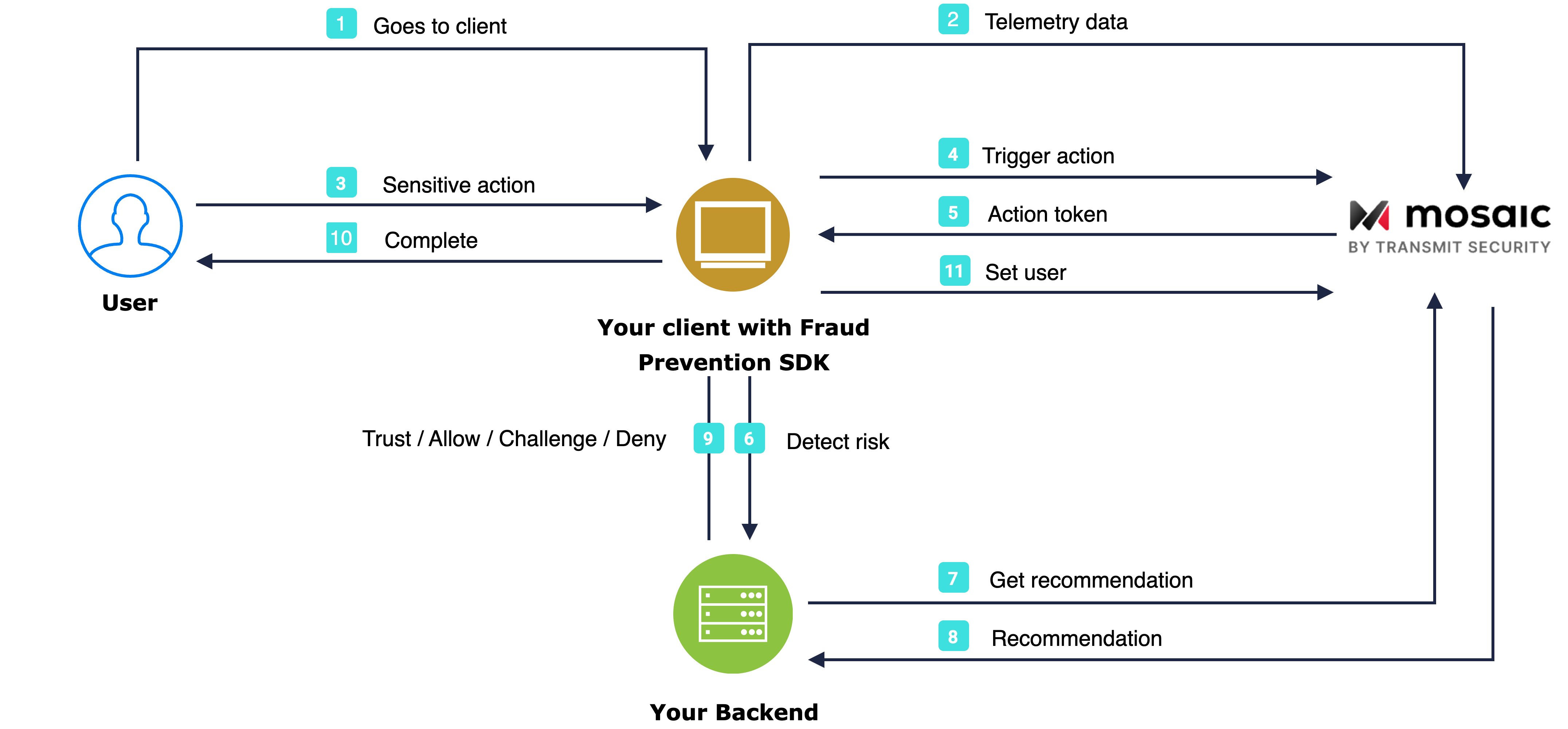Mosaic enables you to integrate Fraud Prevention into your application using client-side SDK or backend API approach.
This article explains the difference between these approaches and lists benefits each approach has. For implementation instructions, refer to Quick start guides.
The flow starts with the user navigating to the webpage or app (1). The SDK gets initialized, obtains a device session token, and starts sending telemetry to Mosaic (2). When a user performs an action, for example, clicks a login button (3), your client passes this information to your backend (4) and the backend triggers an action event to Mosaic (5). Having received an action token (6), the application backend uses it to fetch recommendation from Mosaic (7 & 8) and instructs the client to act accordingly (9) in order to complete the login procedure (10). As a last step, your server can report the action result back to Mosaic and set the user (11).

The flow starts with the user navigating to the webpage or app (1). The SDK gets initialized and starts sending telemetry to Mosaic (2). When a user performs an action, for example, clicks a login button (3), the SDK triggers an action event (4) and obtains an action token (5) which then forwards to the backend (6). Having received an action token, the application backend uses it to fetch recommendation from Mosaic (7 & 8) and instructs the client to act accordingly (9) in order to complete the login procedure (10). Upon successful login, the client sets the user (11).

Any Fraud Prevention integration requires you to install and initialize the relevant Mosaic's SDK (for Web, Android, or iOS, etc.) in order to collect and stream telemetry data to Mosaic.
The major difference comes in triggering events for user actions and processing the recommendations for those actions.
The backend integration relies on the concept of device session token—a unique opaque token that binds interactions to a device. Naturally, the backend integration handles triggering the actions and other tasks through the APIs coming from your server. These calls include:
Although in the client-side integration, recommendations are still obtained with the backend API call (Fetching recommendation), the following tasks are performed via SDK:
- Triggering an action event (for example, see Web SDK)
- Setting the user (for example, see Web SDK)
- Clearing the user (for example, see Web SDK)
Backend integration: Mosaic recommends implementing an integration leveraging backend APIs for production applications. This approach allows you to build flexible logic server-side logic depending on obtained recommendations. For detailed instructions, see Backend API quick start guide.
- Is more secure—action triggering is controlled by the app backend with no data being exposed to clients.
- Allows for optimizations and has lower latency on the backend—for example, triggering an action event with
get_recommendation=truesaves the Get recommendation API call. - Has lower latency for the end-user and less impact on the client
- Streamlines implementation—no need to manage triggering action events across your web and mobile applications, the action event triggering and managing the user identity is centralized on the backend.
Client-side integration: Integrations leveraging mostly client-side SDK calls are lightweight and recommended for POC, MVP, and test applications. For example, refer to Web SDK quick start guide for detailed instructions.
- Is faster to implement and roll out (requires only minimal backend).
- Is suitable for monitoring mode—can be done without any backend which caters to the use cases when the app is only collecting telemetry data while the risk analysis is handled outside Mosaic.